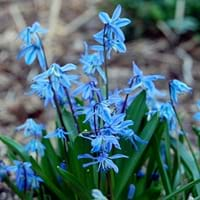Life Span
Perennial
Perennial
Type
Fruit
Bulb or Corm or Tuber
Origin
Eastern Asia
Russia/Siberia, Western Asia
Types
Actinidia arguta, Actinidia giraldii, Actinidia hypoleuca
Not Available
Number of Varieties
Not Available
Habitat
Dappled Shade, open Woodlands
gardens, Moist Soils, open Woodlands, Roadsides
USDA Hardiness Zone
3-8
5-8
Sunset Zone
1a, 1b, 2a, 2b, 3a, 3b, 4, 5, 6, 7, 8, 9, 14, 15, 16, 17, 18, 19, 20
21,22
Habit
Vining/Climbing
Clump-Forming
Flower Color
White, Ivory
Blue
Flower Color Modifier
Bicolor
Bicolor
Fruit Color
Green, Yellow green
Green, Brown
Leaf Color in Spring
Green, Dark Green
Green
Leaf Color in Summer
Dark Green
Light Green
Leaf Color in Fall
Dark Green
Several shades of Green
Leaf Color in Winter
Light Green
Light Green
Leaf Shape
Oval
Grass like
Plant Season
Spring, Summer, Fall
Spring
Sunlight
Full Sun, Partial Sun
Full Sun, Partial Sun
The pH of Soil
Neutral
Acidic, Neutral
Soil Drainage
Well drained
Well drained
Bloom Time
Spring, Late Spring, Early Summer
Early Spring
Tolerances
Shade areas
Drought
Where to Plant?
Ground, Pot
Container, Ground, Pot
How to Plant?
Grafting, Stem Cutting
Corms or bulbs, From bulbs, Offsets, Seedlings
Plant Maintenance
Low
Medium
Watering Requirements
Average Water Needs, Requires regular watering
Keep the Soil well drained, Requires regular watering
In Summer
Regular watering required
Lots of watering
In Spring
Moderate
Moderate
In Winter
Average Water
Average Water
Soil pH
Neutral
Acidic, Neutral
Soil Drainage Capacity
Well drained
Well drained
Sun Exposure
Full Sun, Partial Sun
Full Sun, Partial Sun
Pruning
Remove damaged leaves, Remove dead branches, Remove dead leaves
Remove damaged leaves, Remove dead branches, Remove dead leaves
Fertilizers
Apply 10-10-10 amount, fertilize twice a year
All-Purpose Liquid Fertilizer
Pests and Diseases
Botrytis head rot, Japanese Beetles, Leaf Rollers, Nematodes, Phytophthora, Root rot, Sclerotinia blight, Spider mites, Thripes
Pest Free
Plant Tolerance
Shade areas
Drought
Flower Petal Number
Single
Single
Foliage Texture
Medium
Medium
Foliage Sheen
Glossy
Glossy
Attracts
Cats
Not Available
Allergy
Not Available
contact allergic dermatitis, poisonous if ingested
Aesthetic Uses
Cottage Garden
Beautification, Cottage Garden, Ground Cover
Beauty Benefits
Not Available
Not Available
Environmental Uses
Shadow Tree
Air purification
Medicinal Uses
Antioxidants, Fiber, Folate, Rich in Potassium, Vitamin C
No Medicinal Use
Part of Plant Used
Fruits
Flowers
Other Uses
Grown for shade
Not Available
Used As Indoor Plant
No
Yes
Used As Outdoor Plant
Yes
Yes
Garden Design
Edible, Feature Plant, Vine
Mixed Border, Rock Garden / Wall
Botanical Name
ACTINIDIA arguta
SCILLA siberica
Common Name
Hardy Kiwi
Siberian Squill, Siberian Wood Squill
In Hindi
हार्डी कीवी
Scilla siberica
In German
Hardy Kiwi
Sibirischer Blaustern
In French
kiwai
Scille de Sibérie
In Spanish
kiwi hardy
siberica Scilla
In Greek
σκληραγωγημένα ακτινίδια
Scilla siberica
In Portuguese
kiwi Hardy
Scilla siberica
In Polish
hardy kiwi
Cebulica syberyjska
In Latin
Hardy kiwi
Scilla siberica
Phylum
Magnoliophyta
Tracheophyta
Class
Magnoliopsida
Magnoliopsida
Order
Theales
Asparagales
Family
Actinidiaceae
Asparagaceae
Clade
Angiosperms, Asterids, Eudicots
Angiosperms, Monocots
Tribe
Not Available
Not Available
Subfamily
Actinidiaceae
Scilloideae
Number of Species
Not Available
Difference Between Hardy Kiwi and Siberian Squill
If you are confused whether Hardy Kiwi or Siberian Squill are same, here are some features about those plants to help you choose better. Many people think that these two plants have the same characteristics, but one can see Hardy Kiwi and Siberian Squill Information and learn more about it. Fertilizers required for proper growth of Hardy Kiwi are Apply 10-10-10 amount and fertilize twice a year, whereas for Siberian Squill fertilizers required are All-Purpose Liquid Fertilizer. Hence, one should know the basic difference between Hardy Kiwi and Siberian Squill if you are planning to have them in your garden to enhance its beauty.
<
Flowering PlantsImportance of Hardy Kiwi and Siberian Squill
Want to have the most appropriate plant for your garden? You might want to know the importance of Hardy Kiwi and Siberian Squill. Basically, these two plants vary in many aspects. Compare Hardy Kiwi and Siberian Squill as they differ in many characteristics such as their life, care, benefits, facts, etc. Every gardener must at least have the slightest clue about the plants he wants to plant in his garden. Compare their benefits, which differ in many ways like facts and uses. The medicinal use of Hardy Kiwi is Antioxidants, Fiber, Folate, Rich in Potassium and Vitamin C whereas of Siberian Squill is No Medicinal Use. Hardy Kiwi has beauty benefits as follows: Not Available while Siberian Squill has beauty benefits as follows: Not Available.
Compare Facts of Hardy Kiwi vs Siberian Squill
How to choose the best garden plant for your garden depending upon its facts? Here garden plant comparison will help you to solve this query. Compare the facts of Hardy Kiwi vs Siberian Squill and know which one to choose. As garden plants have benefits and other uses, allergy is also a major drawback of plants for some people. Allergic reactions of Hardy Kiwi are Not Available whereas of Siberian Squill have contact allergic dermatitis and poisonous if ingested respectively. Having a fruit bearing plant in your garden can be a plus point of your garden. Hardy Kiwi has no showy fruits and Siberian Squill has no showy fruits. Also Hardy Kiwi is not flowering and Siberian Squill is not flowering . You can compare Hardy Kiwi and Siberian Squill facts and facts of other plants too.





